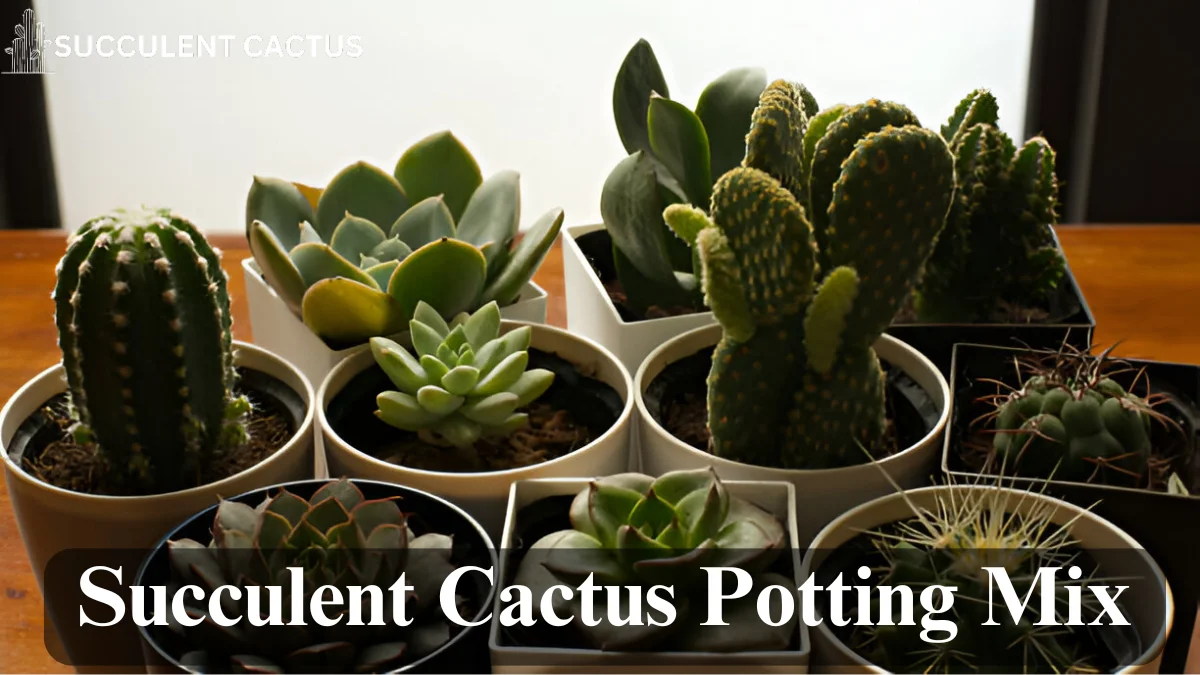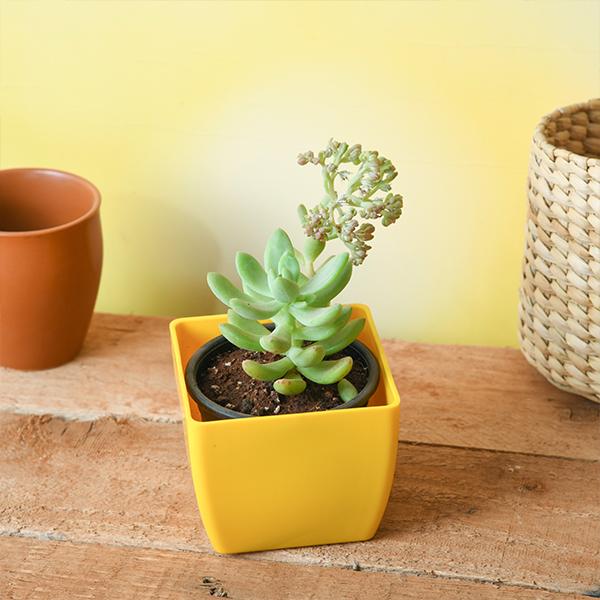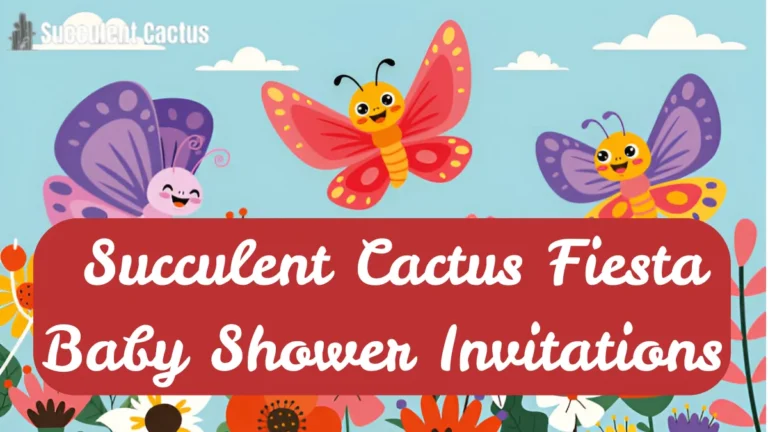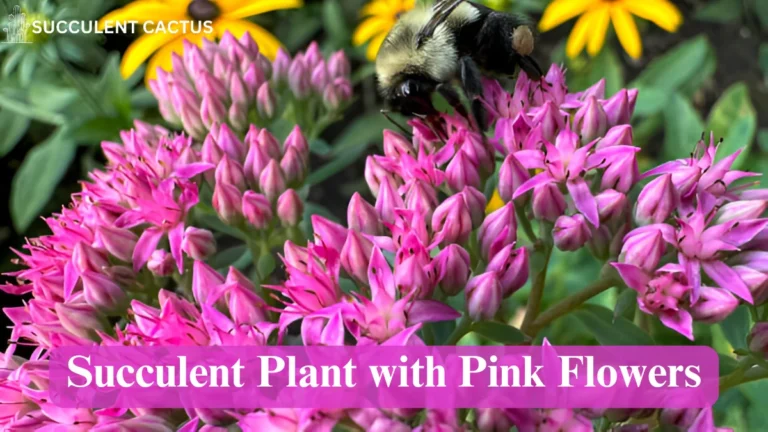The Ultimate Guide to Succulent Cactus Potting Mix

Succulent cactus plants thrive in specific soil conditions tailored to their needs. The right succulent cactus potting mix ensures their health, supports growth and prevents common problems like root rot. In this guide, we will cover everything you need to know about crafting and maintaining the ideal potting mix for your succulents and cacti.
Understanding the Importance of Succulent Cactus Potting Mix
The potting mix plays a crucial role in the growth and survival of succulent cactus plants.
Why Regular Soil Doesn’t Work
Unlike regular garden plants, succulents and cacti have specialized needs.
- Poor Drainage: Regular soil holds too much water, leading to root rot.
- Lack of Aeration: Dense soil restricts air circulation around roots, suffocating the plant.
- Nutrient Imbalance: Succulents and cacti require fewer nutrients than traditional garden plants.
Unique Needs of Succulents and Cacti
Succulents and cacti have evolved to survive in arid, nutrient-poor environments.
- Quick Draining Soil: They need soil that dries out quickly to mimic their natural habitat.
- Low Organic Matter: Excess organic matter can hold moisture, harming the roots.
- Mineral Content: Gritty soil improves drainage and prevents compaction.
How the Right Potting Mix Benefits Plants
Using the correct potting mix ensures healthier, more resilient plants.
- Reduces the risk of fungal infections and pests.
- Supports proper root development.
- Encourages vibrant growth and flowering.
Components of a Succulent Cactus Potting Mix
An ideal potting mix includes specific ingredients that balance drainage, aeration, and nutrition.
Sand for Drainage
Sand is a key component for improving drainage in succulent soil.
- Coarse Sand: Use builder’s sand or horticultural sand instead of fine sand, which compacts easily.
- Function: Sand prevents water from pooling around roots and promotes aeration.
Perlite and Pumice
These lightweight materials enhance the texture of the soil.
- Perlite: A volcanic glass that creates air pockets and improves drainage.
- Pumice: A more durable option that provides similar benefits while adding weight to the mix.
- Proportions: Use 1 part perlite or pumice for every 2 parts of the potting mix.
Organic Matter
Even succulents and cacti need a small amount of organic material.
- Compost or Coconut Coir: Provides essential nutrients without retaining too much water.
- Caution: Avoid overly rich composts that may burn delicate roots.
Creating Your Own Succulent Cactus Potting Mix
Making your potting mix allows you to tailor it to the specific needs of your plants.
Basic Recipe
Follow this simple recipe for an all-purpose succulent mix:
- 2 parts coarse sand
- 1 part potting soil (low in organic matter)
- 1 part perlite or pumice
Customizing for Specific Cacti or Succulents
Different species may have slightly different soil needs.
- For Desert Cacti: Increase sand and pumice for maximum drainage.
- For Jungle Cacti: Add more organic matter to replicate their natural rainforest environment.
- Test the Mix: Check how quickly water drains to ensure it matches your plant’s requirements.
Tips for Mixing and Storing
- Mix small batches to avoid waste.
- Store extra soil in an airtight container to prevent contamination.
- Sterilize soil components if reusing them.
Choosing a Commercial Succulent Cactus Potting Mix
If you prefer convenience, you can buy ready-made potting mixes.
Key Features to Look For
Not all commercial mixes are created equal. Check for:
- Gritty Texture: Avoid mixes that feel too soft or compact.
- No Fertilizer: Choose a mix without added fertilizers to avoid overfeeding your plants.
- Organic-Free Options: Look for low-organic mixes specifically labeled for cacti and succulents.
Top Brands to Consider
Several reputable brands cater to succulent enthusiasts:
| Brand Name | Key Features | Price Range |
| Miracle-Gro Cactus Mix | Affordable and widely available | $5–$10 |
| Black Gold Cactus Mix | Great for beginners | $8–$15 |
| Hoffman Organic Cactus Soil | Rich in nutrients for slow-growers | $10–$20 |
Comparing Commercial and Homemade Mixes
While commercial mixes save time, homemade blends give you more control. For advanced growers, crafting your mix is often the better choice.
Testing and Adjusting the Soil Mix
Before planting, test your potting mix to ensure it meets the plant’s needs.
The Drainage Test
Check how quickly water drains through your soil:
- Method: Pour water through the mix in a pot with a drainage hole.
- Ideal Time: Water should drain within 30 seconds to 1 minute.
Measuring pH Levels
Succulents and cacti prefer slightly acidic soil.
- pH Range: Aim for a pH between 5.5 and 6.5.
- Testing Tools: Use a soil pH tester or litmus strips for accuracy.
Observing Plant Growth
Monitor your plants over time to see how well they respond.
- Healthy Plants: Vibrant leaves, steady growth, and firm roots.
- Warning Signs: Yellowing leaves or soggy soil may indicate poor drainage.
Preparing Pots for Succulent Cactus Plants
The pot is just as important as the soil when it comes to plant health.
Importance of Drainage Holes
Always choose pots with drainage holes.
- Why It Matters: Excess water needs to escape to prevent root rot.
- Alternative Options: If using a pot without holes, create a drainage layer using pebbles.
Best Pot Materials for Succulents
Different materials offer unique benefits:
- Terracotta: Absorbs moisture and allows airflow, making it ideal for succulents.
- Ceramic: Retains less heat, protecting roots from overheating.
- Plastic: Lightweight and affordable, but ensure proper drainage.
How to Layer Your Potting Mix
For better results, layer the pot with:
- Pebbles or gravel at the bottom.
- Potting mix in the middle.
- Topdressing (e.g., rocks) for aesthetics and moisture retention.
Watering and Soil Care Tips for Succulents and Cacti
Even with the right potting mix, watering practices play a vital role in maintaining healthy plants.
Watering Frequency
Succulents and cacti thrive on infrequent watering.
- Basic Rule: Allow the soil to dry out completely between waterings.
- Seasonal Changes: Water less during winter when plants go dormant.
- Indicators: Check for droopy leaves or wrinkling, which signal that it’s time to water.
How to Water Properly
Improper watering is the most common cause of plant death.
- Direct Application: Pour water at the base of the plant to avoid wetting leaves.
- Soak and Dry Method: Water thoroughly until excess drains out, then wait for the soil to dry.
- Avoid Overwatering: Overwatered soil feels soggy and may smell musty.
Maintaining Soil Quality
Keep the potting mix effective for longer.
- Remove dead leaves to prevent mold or fungal growth.
- Repot every 1–2 years to refresh the soil and provide space for root growth.
- Avoid compacting the soil by handling it gently during planting.
Common Problems with Potting Mix and Their Solutions
Despite the best preparations, issues may still arise with your potting mix.
Soil Compaction
Over time, the soil may lose its aeration.
- Causes: Watering too frequently or using improper soil ingredients.
- Solutions: Mix in fresh sand or perlite to restore texture and drainage.
Fungal Infections
Poor drainage often leads to fungal growth.
- Signs: Black spots, white mold, or a foul smell.
- Prevention: Sterilize soil components before use and avoid overwatering.
- Treatment: Remove infected areas and replace the soil if necessary.
Nutrient Deficiency
Succulents and cacti may show stunted growth or pale leaves.
- Causes: Lack of nutrients in low-organic soil mixes.
- Solutions: Use a diluted, cactus-friendly fertilizer during the growing season.
- Pro Tip: Avoid over-fertilizing, as it can burn delicate roots.
Fertilizing Succulent Cactus Plants
Even with the best soil, occasional fertilizing can boost plant health.
When to Fertilize
Timing is crucial when applying fertilizer.
- Growing Season: Fertilize once every 4–6 weeks during spring and summer.
- Dormancy Period: Avoid fertilizing in fall and winter when the plant’s growth slows.
- After Repotting: Wait at least one month before fertilizing to let the plant acclimate.
Choosing the Right Fertilizer
Succulents and cacti have unique nutritional needs.
- Low Nitrogen Content: opt for balanced or cactus-specific fertilizers (e.g., 10-10-10 or 5-10-10).
- Liquid Fertilizers: These provide quick absorption and are easy to dilute.
- Organic Options: Use compost tea or fish emulsion sparingly.
How to Apply Fertilizer
Follow these steps for safe fertilizing:
- Dilute fertilizer to half or quarter strength.
- Water the plant first to prevent root burn.
- Pour the solution evenly around the base of the plant.
Eco-Friendly Practices for Succulent Cactus Potting Mix
Creating sustainable soil blends benefits both your plants and the environment.
Composting Organic Matter
Instead of store-bought compost, make your own.
- Materials: Use vegetable scraps, coffee grounds, and dry leaves.
- Method: Allow the mixture to decompose fully before use.
- Benefits: Reduces waste and enriches soil naturally.
Reusing Soil
Recycling soil reduces waste and saves money.
- Remove old roots and debris from the soil.
- Sterilize the soil by baking it at 180°F for 30 minutes to kill pathogens.
- Mix in fresh ingredients like sand or perlite before reusing.
Avoiding Harmful Additives
Some commercial products contain harmful chemicals.
- Read Labels: Avoid mixes with synthetic pesticides or non-biodegradable components.
- Natural Alternatives: Use neem oil or diatomaceous earth to manage pests safely.
Case Studies: Successful Succulent and Cactus Growth
Real-life examples highlight the importance of a good potting mix.
Case Study 1: Overwatered Jade Plant
A grower used regular garden soil for their jade plant, leading to root rot. After switching to a sandy, well-draining mix, the plant recovered within months, showcasing the value of proper soil.
Case Study 2: Thriving Echeveria in DIY Mix
A succulent enthusiast created a custom mix using coarse sand, coconut coir, and perlite. Their Echeveria grew vibrant leaves and produced offsets within a year.
Case Study 3: Commercial Mix Success
A beginner used a branded cactus soil mix and followed proper watering practices. Their Golden Barrel Cactus thrived for three years without repotting, proving that store-bought mixes can be effective.
Decorating and Topdressing for Succulent Displays
Aesthetics can enhance the beauty of your succulent arrangements.
Using Decorative Stones
Topdressing with stones adds visual appeal and functional benefits.
- Prevents Erosion: Keeps soil in place during watering.
- Types of Stones: River pebbles, crushed quartz, or polished rocks.
- Color Matching: Coordinate stone colors with your pot and plant.
Layered Arrangements
Create eye-catching displays with layered materials.
- Add a layer of colored sand below the topdressing.
- Use glass containers to highlight the layers.
- Combine different textures for a modern look.
Incorporating Moss and Driftwood
Natural elements add charm to succulent arrangements.
- Moss: Preserved moss adds greenery without extra watering needs.
- Driftwood: Provides a rustic touch, especially in outdoor displays.
FAQs About Succulent Cactus Potting Mix
1. What is the best potting mix for succulents and cacti?
A mix of coarse sand, perlite, and low-organic potting soil works best. Commercial cactus soil is also a good option.
2. Can I use regular potting soil for succulents?
Regular potting soil holds too much water and lacks proper drainage. Always amend it with sand or perlite.
3. How often should I replace succulent soil?
Repot and refresh the soil every 1–2 years or when the plant outgrows its container.
4. Is sterilizing soil necessary for succulents?
Yes, sterilizing soil prevents pests and diseases, especially if you’re reusing soil.
5. How can I tell if my soil mix is draining properly?
Water should drain completely within a minute. Soggy soil indicates poor drainage.
Conclusion
Creating the perfect succulent cactus potting mix is essential for growing healthy, beautiful plants. By understanding their unique needs, selecting the right components, and practicing sustainable gardening, you can ensure your succulents and cacti thrive for years. Whether you prefer making your mix or using a commercial option, the key lies in balancing drainage, aeration, and nutrients. With these tips and strategies, you’ll grow a stunning collection of resilient, vibrant plants!






